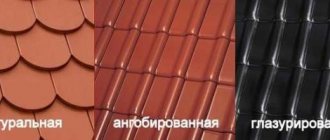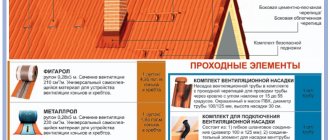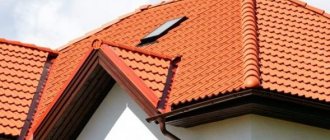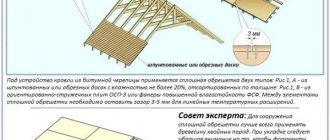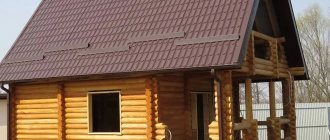Currently, the demand for healthy, environmentally friendly housing is constantly growing.
Many homeowners, when building cottages for their families, prefer to purchase natural building materials. One of them is beautiful, reliable and durable ceramic tiles. Clay tiles are the oldest material made from natural raw materials, and have been used as roofing for more than four thousand years. .[contents]
Different shapes of clay tiles
Roofing with clay tiles and its installation emphasizes the exquisite charm of not only fashionable mansions, ancient castles, temples and churches, but also completely modern buildings. In many Western countries, for example, in Germany, more than half of all buildings are faced with such tiles. Ceramic tiles are considered one of the most popular materials in Europe not only because of their excellent qualities, but also because of their relatively low cost. The presence of many quarries for clay extraction significantly reduces the cost of material for the manufacturing companies that own them.
Meanwhile, this Russian roofing covering has long had its own niche in the domestic market, although it is used mainly for expensive mansions and status objects. However, recently sales of natural tiles have noticeably intensified, due to the emergence of many new buildings in need of prestigious finishing. In addition, clay tiles are used for the restoration of churches and ancient mansions.
Characteristic
Clay tiles are a material that has occupied a leading position in the sales market for many years. Clay is used as the basis, resulting in a reliable structure that can protect any structure. Taking into account the requirements of GOST, the process occurs in several stages:
- Preparation of the main product. They are considered to be pottery clay. Special additives are added to it - plasticizers.
- Stamping of the final component using various techniques.
- Burning of workpieces in an oven at high temperature.
From this it becomes clear that the quality of the material is high. It is not for nothing that he has been occupying the first position in the construction market for many years.
Analogs
Today, the production of clay tiles occupies a leading position, as the demand for it does not decrease. Clay is also sometimes called sand-ceramic. Most often, the basis is raw materials from fatty varieties and modifiers, which increases the service life and technical characteristics. Today there are analogues that are no less effective. They are the following:
- Cement-sand. It is based on cement. This is a reliable material that is in no way inferior to tiles. The cost will be a little cheaper, but there is a minus. This is a lot of weight, so it is inconvenient to work with it. It is also worth strengthening the floors.
- Soft clay roof tiles. These are two layers that differ from each other: one is inside, the other is outside. When working with them, it is worth considering some features.
- Polymer-sand. This roofing material does not differ much from tiles, but a wide range of colors and low weight are advantages.
There are many options that can become a substitute. At the same time, each has its own disadvantages and characteristics of flooring. The decision is always made by the owner, guided by his desires and capabilities.
Pros and cons of clay tiles
Speaking about such roofing material, it is worth noting that its production is due to certain features. The main advantage of clay tiles is that it is an environmentally friendly material. Since clay is used as a basis, it is possible to create a good microclimate in the room. How does this manifest itself? This material allows the entire room to “breathe”.
During operation, this roofing material shows its best side. Masters highlight the following positive points:
- The structure of the material is porous, but it does not allow water to leak. Even after strong and prolonged exposure to rain (as well as other precipitation), such roofing material does not lose its properties and protects the structure.
- Ceramic tiles have a long service life (up to 100 years).
- Tolerates any frost.
- Ultraviolet radiation does not have a strong impact, so this roofing material is suitable for southern regions.
- Does not corrode or deform.
- Since the tiles are small, it is quite possible to organize ventilation of the building and avoid the greenhouse effect.
- High strength.
- Good sound insulation. In addition, the house is not hot in summer and not cold in winter. Even in the presence of strong wind, no sounds enter the room.
- Everyone can handle styling. Since the pieces connect to adjacent ones in a puzzle effect, anyone can make repairs. If one element is damaged, then there is no need to install the entire structure from scratch. It is enough to replace only the one that was damaged earlier. But you need to remember that the shades of such tiles may differ. Therefore, it is important to choose a material that will best match the tone of the current coating.
- Clay does not allow electrostatic charge to accumulate. Therefore, there is no need to create grounding. Thanks to this, time is saved significantly.
- A house with such a roof looks attractive and beautiful.
There are always a wide variety of colors on sale. These are natural shades that allow you to create the uniqueness of the entire structure. Masters believe that there are always disadvantages to any material. One of them is a lot of weight, so the supporting structures must be strong. Despite its high reliability, baked clay can break during transportation or installation. It is important to pay special attention to this. But everything becomes insignificant, since there are many advantages.
Natural clay tiles: advantages
- One of the undoubted advantages of the material is its amazing resistance to various external influences. The tiles are not afraid of significant temperature fluctuations, the harsh influence of ultraviolet radiation, and various chemical elements found in sediments and the environment.
- The versatility of the material allows it to be used to cover any roof shape.
- Non-flammability. In production
the tile heats up above a thousand degrees, acquiring the ability not to support combustion and not to catch fire. - Ceramic tiles, especially those with an engobed or glazed coating, have excellent waterproofing properties. It almost does not absorb moisture at all, protecting the home from the negative consequences caused by dampness.
- Another remarkable quality of clay tiles is their high soundproofing ability, thanks to which they successfully absorb various noises, for example, from hail or rain.
- Vapor permeability. The tile is an environmentally friendly material that can “breathe”. Thanks to its ability to pass air into the under-roof space, it helps create a favorable microclimate in the home.
- This roofing material hardly heats up under the hot rays of the sun, minimizing the possibility of condensation, which is harmful to chimneys. In addition, thermal insulation is not required for a tiled roof.
- Excellent thermal insulation qualities and high frost resistance - these important advantages allow the material to be successfully used in different climatic zones.
- Low windage rates. The weight of clay tiles allows them to successfully withstand not only strong winds, but also natural elements.
- Zero electrical conductivity. The material does not accumulate a charge, and therefore the roof does not need grounding.
- Long service life. Typically, manufacturers provide up to 50 years of warranty on products, but their actual service life reaches hundreds of years or more.
- Respectability. For a long time, a tiled covering has been not only a decoration of a home, but also an indicator of a certain status of its owner.
- Rationality. The tiles have a high cost, but years of impeccable service justify it. It serves for decades without needing updating or repair.
Ceramic tiles: installation
A technically complex process must be carried out by specialists with skills and experience in such work. Only high-quality work on the installation of roofing guarantees its long and full operation, providing the inhabitants of the home with the appropriate level of comfort.
Installation of ceramic tiles
The roof must have a sufficient slope, otherwise if a large amount of snow falls, moisture may penetrate under it. If the slope is less than 10 degrees, additional waterproofing must be applied. Lathing will not be enough: a continuous flooring will be required.
The method of laying tiles depends on its type . Flat tiles are always laid in two or three layers with a significant overlap, like scales. One layer of such coating will not provide the roof with the required water resistance.
The exception is the “beaver tail” variety, which can be laid using a special solution in just one layer.
Strip groove tiles are laid in one layer. Vertically it requires an overlap of about 8 cm, horizontally its size should be equal to the width of the groove. This type of ceramic tile is equipped with longitudinal grooves that contribute to the tightness of the joints of adjacent plates. Also, stamped groove tiles, which are directly related to strip tiles, are laid in one layer. Here the individual plates are also fastened to each other by means of grooves.
In Mediterranean countries, grooved ceramic tiles are widespread, consisting of two layers: a concave bottom and a convex top. This material not only has excellent water resistance, it also has the ability to self-ventilate, eliminating the need for additional ventilation. But these tiles have the highest consumption per unit area, making them one of the most expensive varieties.
Cement sand tiles
This type of roofing material is another type of natural tile. In another way it is called cement or concrete. It consists of quartz sand, cement and a special coloring pigment.
In other words, this is a product made of lightweight concrete. Its manufacturing technology makes it possible to obtain a durable material with high density.
The service life of a roofing covering made from it can reach one hundred years. The performance characteristics and performance qualities of sand-ceramic tiles are extremely close to those of clay tiles. Even the mass of one square of coating is approximately the same. But with this material, the coloring pigment is added to the prepared mixture immediately, so the tile has the same color throughout its entire depth.
The edges of the concrete tiles look as if they are slightly chopped off, which impairs the aesthetics of the coating when viewed from above. But if you look from the outside, this feature is practically not noticeable. What makes the material particularly attractive is its cost. For example, Braas tiles have an average price of 36 rubles per piece.
Natural ceramic tiles: products of the modern market
High-quality clay tiles, which are in constant demand, are represented on our market mainly by products of foreign companies. Which brands are the most popular?
Types of modern tiles
- German Braas.
- German Erlus.
- Austrian Koramic.
- Polish ceramic tiles Roben
According to their purpose, all tiles are divided:
- Ordinary - the roof itself is covered with this material;
- Ridge - spreads on the roof ridge after completion of installation;
- Edge or wind (left and right) - mounted from the very edge. The main difference from the ordinary one is a special wind strip that protects the rafters from wind and rain.
The variety of ceramic tile roofs is extremely large. It is no coincidence that it is one of the favorite design materials.
Types of clay tiles
There are many colors and shapes, but there are only three types, and they are worth noting. What everyone can find in the store:
- Flat tiles. It is similar to the design of a shovel. Quite suitable for buildings with complex lines. Installation is carried out with a slight overlap, comparable to scales. This will completely prevent moisture from entering.
- Grooved. It would also be quite appropriate for roofs with an extraordinary design. This design is made in two layers. These are concave and convex shards. They are connected in pairs so that the structure looks good and provides maximum protection. Because of this, the material consumption becomes 2 times greater.
- Wave-like appearance. Most often found on country houses, it looks beautiful. There are two varieties - one- and two-wave.
Ceramic tiles have special grooves in their design, so waste water quickly drains away and the level of reliability does not decrease. There are also groove designs. They are easier to work with - even a beginner can handle the installation. Before you go to the store, you should understand what is most suitable and in which direction to make your choice.
How to cover the roof?
Here are the types of products:
- Natural is ceramic tiles without additional coating. The clay simply burns. Suitable for creating a retro style. The shade is natural, most often reddish. During use, this shade may become slightly darker. The clay used for this is different. The manufacturer also offers colors with differences.
- Glazed is an interesting coating that attracts attention regardless of the chosen shade. The basis is a glassy substance containing various metal ions. This increases the moisture-proof properties of clay tiles. The design looks beautiful and can completely change the perception of the building as a whole. With all the positive qualities, there are also minor disadvantages - low resistance to frost, as well as cracking of the surface. In addition, the price of such roofing material is high.
- Engobed. The main difference is the variety of colors and shades. This is achieved by using different colored clays. It is applied to the surface in a thin layer and subjected to heat treatment. But this will not work if you do not use mineral supplements. The technology chosen is such that the color does not change despite the influence of nature. Using this method provides additional protection. Therefore, at high temperatures the material does not crack.
Everyone decides what is right for them, taking into account temperature conditions in the region and personal preferences. It is worth purchasing material only from trusted manufacturers.
Today, the production of clay tiles occupies a leading position, as the demand for it does not decrease. Clay is also sometimes called sand-ceramic. Most often, the basis is raw materials from fatty varieties and modifiers, which increases the service life and technical characteristics. Today there are analogues that are no less effective. They are the following:
- Cement-sand. It is based on cement. This is a reliable material that is in no way inferior to tiles. The cost will be a little cheaper, but there is a minus. This is a lot of weight, so it is inconvenient to work with it. It is also worth strengthening the floors.
- Soft clay roof tiles. These are two layers that differ from each other: one is inside, the other is outside. When working with them, it is worth considering some features.
- Polymer-sand. This roofing material does not differ much from tiles, but a wide range of colors and low weight are advantages.
There are many options that can become a substitute. At the same time, each has its own disadvantages and characteristics of flooring. The decision is always made by the owner, guided by his desires and capabilities.
Ceramic tiles: production and its design
Elements of a tiled roof
Even before entering the factory, the clay raw materials extracted from the quarry are cleaned of foreign impurities and inclusions.
The process of its primary processing and preparation is quite complex and labor-intensive: the resulting mixture must be homogeneous and have minimal porosity. The clay is crushed and crushed in special machines, then goes into storage for a while.
Only after a certain period of time, after a series of preparatory operations, the mass is fed to the production line. A specially developed multi-phase process gives the individual grains of the material a minimum size, which provides the raw material with the required plasticity index.
The direct process of manufacturing the material is divided into separate stages. To make the material, it is possible to use clay of various types, which is mixed in specified proportions.
From it, blanks of the desired shape are formed, which need to be dried. They must be dried to such an extent that no more than 5-6% moisture remains in them to eliminate the possibility of deformation of the tiles. Then it is coated with a special composition and fired at high temperatures (more than 1000 degrees) in tunnel kilns.
Previously, before the advent of modern technologies, it was difficult to provide a standard size of tiles on an industrial scale so that they were all the same.
Now this problem does not exist; individual products have a given size, which greatly simplifies the installation process.
Molding is carried out in two different ways:
- l
ribbon - the finished tape is cut into separate plates-tiles; - stamping - each individual tile is cast into a metal mold.
The dried product must be painted. For red-colored products, this step is skipped - this is the natural color of the tiles. To give a different color, they undergo a process of glazing or engobing. Engobe is powdery liquid clay.
The minerals contained in it acquire the desired shades when fired. The tiles painted in this way, even after time, do not lose their brightness, do not fade or become covered with moss.
The glaze is a glassy mass with a high content of quartz. For coloring, it is applied to the surface of the product just before firing. As a result, a glossy shiny layer is formed on them, which serves as protection from adverse and aggressive influences.
The material processed by this method is more dense and durable, it is not afraid of water and is able to remain unchanged for a long time.
The possible colors of ceramic tiles are very diverse. To acquire the desired shade, oxides of manganese, copper, cobalt, vanadium, chromium, iron and nickel are introduced into the glaze and clay.
How is installation done?
When preparing the main material, it is worth thinking about a small reserve in case of defects. This product is one of those that comes in batches and they may vary in color. If different colors appear on the roof, it does not always look attractive.
The installation process has several stages:
- Waterproofing is laid on the rafters.
- Afterwards the vapor barrier is fixed.
- The counter-lattice is being installed.
- The beams are laid, onto which the tiles are then fixed. What lathing pitch should I choose? This will depend on the length of the shingles. If there is an overlap, then it is 70-80 centimeters.
What tools are required for the job?
Before you start, you need to prepare everything you need. The first is the tools:
- Cutter.
- Screwdriver.
- Roulette.
- Hammer.
Tiles and any additional components are also purchased. Do not forget about vapor and waterproofing. All this is available at the building materials store. Most often, the roof is assembled using grooves. Although there are also components that need to be placed on adhesive masses.
Installation direction
The direction of installation of clay tiles is from top to bottom and from left to right. When all the rows are laid, you need to cut off the protruding parts of the material that will extend beyond the joints. To prevent warm air from collecting under the roof, it is worth creating a steam outlet. This is done at the level of fixing the waterproofing. For this, holes are created.
There are also situations when you need to cut off a small part. How to do it? Experts recommend soaking any type of clay tile for about 24 hours and then performing the necessary actions. It's not that difficult.
It must be remembered that there are many manufacturers on the market, but out of all the variety, you should give preference to the most reliable and proven ones.
Video description
The video shows the installation process of ceramic tiles:
Installation of tiles on the roof ridge
To do this, use an additional element made using the same technology as the tile itself. It has a peculiar shape that helps to close the ridge hermetically. But since the latter is used in the roofing structure system and as an element of the ventilation system, first a beam is mounted on it on special brackets, and an aeration element in the form of a mesh element is installed on top. It covers the roof ridge, leaving holes for air to escape from under the roof space.
And after that, the ridge additional elements are installed. They are attached to the ridge beam with clamps, because it is this fastener that can ensure the tightness of the ridge assembly. The extensions themselves are assembled using a socket connection type. That is, on one side they have a seat with a larger diameter, on the other - a smaller one.
How to properly assemble a roof ridge from ceramic tiles Source krovsm.ru
Installation of spine tiles
This stage is used if a hip or hip roof is erected over houses. Only in these structures are there ridges - the joints of two slopes that form an outer ledge. It, like other protrusions or concavities, is a place of intense exposure to natural precipitation. Plus, in this area the junction of two slopes is made. Therefore, it is very important to properly seal. We will not describe how to do this correctly. Just watch the video footage.
Ceramic tiles: types, characteristics, construction rules + review of the best brands
You will be interested to know that in our advanced digital age, when roofs are made using almost nano-technologies, most buildings in Europe are still covered with real, environmentally friendly tiles. Amazing, isn't it? And there are reasons for this! Ceramic tiles on the roof of a house are rightfully considered an aristocratic choice; they serve faithfully for at least 100 years and are resistant to any weather.
In fact, tiles made from ordinary clay are the embodiment of centuries-old craft traditions, our history. Which is no worse than modern materials made of metal or bitumen, and, thanks to the possibility of producing shards of different shapes and designs, is also not inferior in decorativeness!
And if before this time, in the process of choosing a roofing material, you did not like either metal, shingles, or euro slate, think about it: perhaps you were looking for exactly this option?
Tile installation technology
Note that a roof made of tiles (any) is assembled using almost the same technology. There are, of course, certain differences that relate to the shape and design features of the material. But the basic sequence of operations is the same.
Any installation process begins with design and calculations. Both stages are not easy, the quality of the final result depends on them, so they should be handled by professionals. The only thing we note is that in the process of carrying out calculations, the amount of required roofing material is determined, as well as the number of additional elements: ridge, valley, eaves overhangs, ventilation grilles, etc.
Be sure to carry out a calculation of the rafter system. Tile is a heavy material, which means that powerful rafters and sheathing elements will have to be installed under it. Therefore, at the design stage, the cross-sections of the required lumber and the step of their installation are calculated.
Installation of all types of tiles is the same Source memphite.com
Clay tiles: centuries-old traditions and modern technologies
Clay tiles are one of the oldest and finest roofing materials used throughout the world. And today it is one of the best and most reliable roofing coverings. Considering that modern ceramic tiles, unlike the experience of previous generations, are made using a completely different technology.
Cement-sand tiles were first invented and produced back in the 18th century in Bavaria. This type of roofing was made manually, and although the technology itself is quite similar to modern technology.
This is what the production of real ceramic tiles looks like:
In tunnel kilns, tiles go through three stages:
- Warming up to 120° . At this moment, physically bound moisture leaves the still wet plates, and the clay material loses its plasticity.
- Firing at temperatures up to 900° . Here, when the temperature reaches from 450 to 600 degrees, all the bound moisture in the shards finally evaporates, and all the tiles acquire their rigidity. The hotter it gets, the faster inorganic impurities burn and the plasticity of the ceramics is lost. And once the threshold of 800°C is exceeded, the surface strength of the plate increases.
- When reaching 1000 degrees Celsius, a low-melting mineral melts in the tiles . The joints envelop and pull together less fusible particles, causing the shingles to settle and compact.
After the oven, the tiles are cooled, and the roofing material acquires its water resistance and strength. The finished ceramic tiles are carefully inspected by specialists, who reject them, mark them and send them to the product warehouse.
And at the same time, the main point of checking tiles remains, as hundreds of years ago, by tapping the plates with a metal object - they should produce a ringing and clear sound.
Types of tile profiles: style and practicality
Modern ceramic tiles please not only with their environmental friendliness and color, but also with their style diversity. The whole secret of this or that design is in the profile, and we will now look at what they are:
- Low profile shingles have a flat section for water drainage and an internal lock. On the roof, such tiles have a slightly wavy appearance. This one, for example, is produced by Koramic.
- Wave tiles with a lock are distinguished by the presence of a concave drainage part and a curved arched surface of the other part.
- Gutter shingles have an internal interlock and a flat water trough, like a cross between flat and low profile shingles.
- Smooth tiles with a concave drainage section that gives the most beautiful wave-like appearance.
- Internal locking tiles have a central rib that gives the tiles special mechanical strength. A separate type is tiles with a smooth surface and an internal lock.
- Roman interlocking tiles immediately stand out among others thanks to their arched shape, which is considered typical of Mediterranean architecture. Even more aesthetically pleasing are tiles with a double arch, which are more economical due to the presence of two waves on the tile.
- Nunk-munn, or “monk-nun.” A true classic! But you will be surprised to learn that the “monk-nun” in Europe is no longer used for private house construction, but for the restoration of historical objects.
- For the roofs of ordinary houses, Mediterranean tiles are usually used - they look as if they have been lying on the roof under the scorching sun for at least 100 years.
- The Romanesque profile, which originated from the Roman, but is also classified as Mediterranean, is considered especially stylish.
Here's what all these types of ceramic tiles look like in real life:
Where do all these species come from? It's all about architectural trends, because once upon a time the graceful curves of roofing elements and ornate decorations were considered the height of craftsmanship.
But today designers strive for purity and strict lines in everything, in order to somehow give comfort to the building among the surrounding chaos and oversaturation. And therefore, the classic flat profile of ceramic tiles is at the height of fashion today.
By the way, if in the process of searching for a nice tile for your own home you come across an unusual shape that is not included in any classification at all, don’t be surprised, modern manufacturers like to pamper their customers with such “goodies.”
Color and design: what is the secret of manufacturers
The real, original color of ceramic tiles is brick, otherwise called terracotta. In catalogs of modern tiles you will also find it under the term “natural red”.
But clay for the production of tiles is mined in a variety of places, and even in the same area it has completely different shades at different depths. As a result, the fired shards have a shade from yellow-terracotta to almost crimson.
And even more: you will hardly find even approximately
Stages
The installation process has several stages:
- Waterproofing is laid on the rafters.
- Afterwards the vapor barrier is fixed.
- The counter-lattice is being installed.
- The beams are laid, onto which the tiles are then fixed. What lathing pitch should I choose? This will depend on the length of the shingles. If there is an overlap, then it is 70-80 centimeters.
What it is?
Natural ceramic tiles are one of the oldest roofing materials, actively used in construction in our time.
The basis of the composition of the material is fatty clay. GOST assumes a multi-stage process for preparing raw materials and manufacturing tiles:
- preparation of raw materials based on pottery clay with the addition of plasticizers;
- molding of tiles by stamping, semi-dry pressing or plastic strip molding;
- firing of blanks in a furnace, the temperature of which is more than 1000C.

